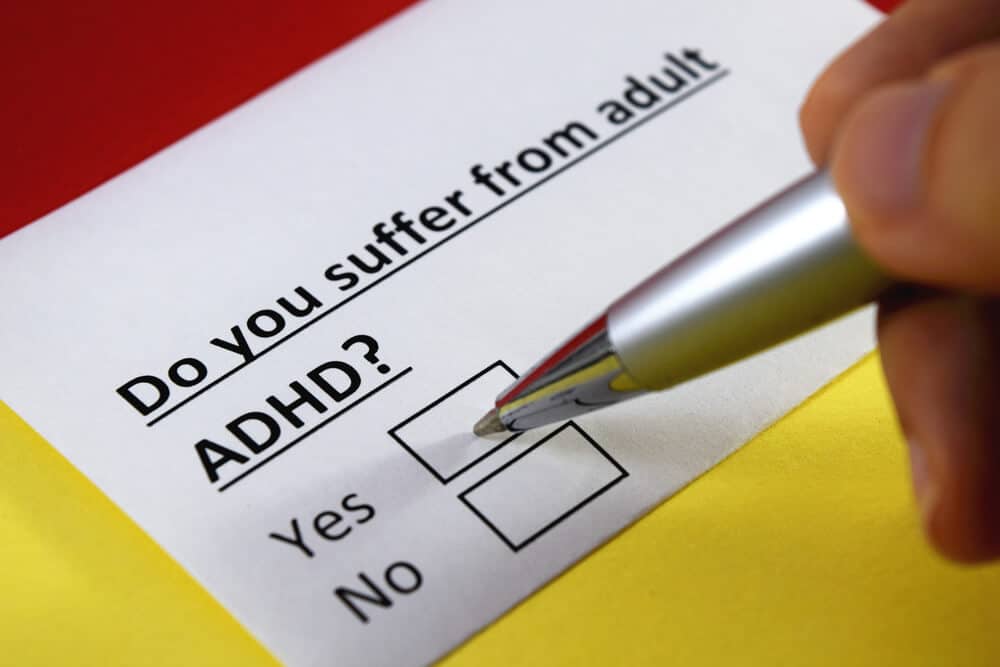What ADHD Looks Like In Adults
“I have time blindness. No matter how much I try or prepare, I’m always 5-30 minutes late and rushing.” — Carrie
“I go on autopilot when I start wandering or doing things on muscle memory and I forget where I go and where I put things.” — Kimberlea
“I constantly worry that every decision I ever made was an impulse and not what I actually feel.” — Anthony
These tweets, from real adults living with attention deficit hyperactivity disorder (ADHD), illustrate how the symptoms of ADHD can look radically different in adults than they do in children.
As a result, it can be more difficult for adults with ADHD to realize they have a problem, talk about their experiences, and receive the help they need to succeed in the workplace, in higher education, and in relationships with others.
Their loved ones may not believe they have a mental illness, and instead assume they are lazy, impulsive, or irresponsible — when in reality, the patient’s forgetfulness, executive dysfunction, and time blindness are all due to adult ADHD.
Contrary to what many people believe, ADHD does not solely affect children. Its symptoms can persist long after your school years have ended. Maybe your ADHD symptoms were missed as a child, or maybe they did not arise until you were older.
Regardless, you are in good company: 10 million adults suffer from ADHD. Many of these people also struggle with additional mental illnesses, such as depression or substance use disorder.
If you have adult ADHD (or suspect you may be struggling with it), we’re here to tell you that you’re not lazy, impulsive, or irresponsible. You’re suffering from a real disorder that has a real impact on your life.
Here is how your ADHD, as an adult, might differ from that of a child — and how to get started with getting help if your ADHD is negatively affecting your ability to succeed.
What is ADHD?
ADHD stands for “attention deficit hyperactivity disorder.”
Neurodivergent advocates argue it is a form of neurodiversity — meaning that it is a natural variant in brain function present in the human species.
Others believe ADHD is a disorder that requires treatment. The DSM-V manual written by the American Psychiatric Association defines it as a diagnosable mental health condition.
Regardless of how you define it, people with ADHD think and behave differently than those of us who are considered “neurotypical.” ADHD symptoms range from mild to severe and can have broad effects stretching across every aspect of a person’s life.
Below, we describe some of the symptoms that might affect a person with ADHD.
Symptoms of ADHD
The DSM-V defines ADHD as “a persistent pattern of inattention and…hyperactivity-impulsivity that interferes with functioning or development.”
What the heck does that mean? Let’s break it down.
A person with ADHD struggles with inattention, which is exactly what it sounds like. They may find it difficult to concentrate or stay focused, especially with respect to social, academic, and occupational activities.
This inattention can result in failure to pay attention to details, meaning a person with ADHD may overlook “careless” mistakes that another person could easily spot. Their attention span may be shorter than the average person’s: they might become easily distracted by stimuli or appear to be daydreaming rather than listening to a conversation.
It can also be difficult for a person with ADHD to stay organized, practice time management, follow instructions, or keep track of their belongings.
People with ADHD also experience hyperactivity. The prefix hyper- essentially means “excess.” Put that together with “activity” and you get someone who has trouble sitting still, fidgets often, operates on autopilot, or is extremely talkative.
Hyperactivity can also include difficulty waiting in lines, blurting out answers or finishing people’s sentences for them, or interrupting or intruding on others’ conversations or activities.
But these behaviors alone are not enough to comprise a diagnosis of ADHD. A person with ADHD must exhibit at least six different behaviors from the “attention deficit” and “hyperactivity” categories.
There must also be a persistent pattern of attention deficit and hyperactivity behaviors. Many of us operate on autopilot, find it difficult to concentrate, or fidget a lot when we are stressed or preoccupied — but when these behaviors last at least six months and interfere with our daily functioning, they might be attributable to ADHD.
The person’s behavior cannot be explained by another medical condition to qualify for a diagnosis of ADHD. For example, an anxiety disorder can make someone appear fidgety, while depression can make it difficult for someone to concentrate. In order for a person to have ADHD, their attention deficit and hyperactivity behaviors cannot occur exclusively in the context of another mental illness.
How ADHD is Different in Adults
If you went to public school, you probably knew at least one student with ADHD.
That child might have been the class clown, constantly interrupting the teacher with jokes. They may have gotten in trouble frequently for running around or climbing on structures when they weren’t supposed to be. Or, they may have received special assistance in the classroom, such as extra time on exams or assignments.
We can all picture what ADHD looks like in children. But children with ADHD must grow up and graduate like the rest of us, and their ADHD does not simply disappear because they have aged.
Some adults may not even have their symptoms recognized until they are older, leading them to receive a diagnosis of ADHD later in life than most. For these adults, it can be especially difficult to find help.
Since ADHD symptoms present differently in adults than they do in children, medical professionals may miss the symptoms of ADHD in an adult. Others mistakenly believe that ADHD only occurs in children, and that an adult cannot be diagnosed with ADHD.
So, what does ADHD look like in adults? The main symptoms of ADHD remain the same, but they look a little different due to the different contexts of adult life.
For example, children with ADHD might forget their homework or make mistakes on assignments, while an adult with ADHD may experience similar symptoms in the workplace. They might have difficulty adhering to deadlines at work, constantly show up late, or fail to notice errors in their work.
While children with ADHD are often energetic, running around the room with boundless energy, hyperactivity tends to present differently in adults. Adults with ADHD are more likely to attempt to contain their excess energy. This can make them appear fidgety, or report feeling extremely restless.
The consequences of ADHD can also be more severe in adults. If a child forgets their homework, they will probably receive a stern warning from their teacher — but if an adult forgets to complete an important presentation for work, they could lose their job.
In general, we also recognize ADHD as more socially acceptable in children than in adults. Children who are hyperactive — leading them to talk too much, interrupt others, or engage in activities too loudly — are often dismissed as having “lots of energy” or being “spirited.”
Other adults, however, might be less accepting of this behavior, assuming that the adult with ADHD should “know better” at this point in their life. This can make it difficult for adults with ADHD to connect with others platonically or romantically, or even to sustain a “normal” conversation with an acquaintance.
Getting Help for Adult ADHD
Adapting to adult life can be especially difficult for a person with ADHD. If you suffer from symptoms of attention deficit and hyperactivity, you might feel disorganized, forgetful, or overwhelmed by your responsibilities.
You might miss important bills you need to pay, or risk losing a job because of frequent mistakes. You may even find it difficult to make new friends or start dating due to the social difficulties presented by ADHD.
If you suffer from adult ADHD, it’s important to recognize that there are many options available to help you navigate the complexities of life.
As someone with ADHD, you may legally qualify as having a “disability.” This can make you eligible to receive financial support from the government if you find it difficult to hold down a job due to your ADHD. It can also help you obtain accommodations in the workplace that will allow you to be more successful.

Talking to your employer about workplace accommodations (which they are legally required to provide) — such as offering structured breaks, providing a job coach, or allowing you to work from home — can help you adapt your occupation to better support your ADHD.
You might also benefit from speaking to an ADHD coach or therapist about the challenges you experience due to ADHD. A trained ADHD professional can help you identify your problem areas and develop solutions to help you adapt your life to better suit your ADHD.
Ready to take the leap and get professional help in managing your ADHD? Reach out to The Meadowglade to talk about how our trained therapists can help you adapt your life to better support your ADHD.

